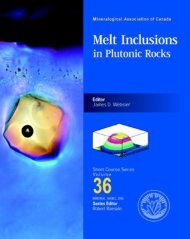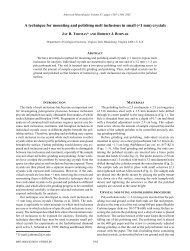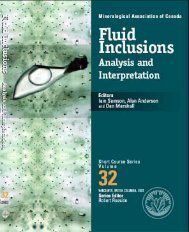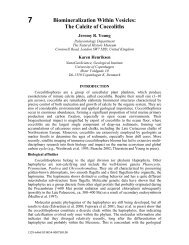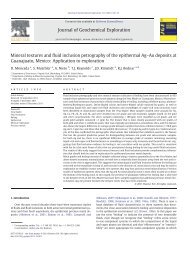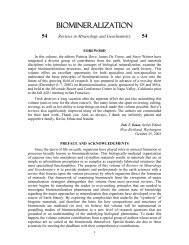Laser Ablation–ICP–MS in the Earth Sciences ... - Virginia Tech
Laser Ablation–ICP–MS in the Earth Sciences ... - Virginia Tech
Laser Ablation–ICP–MS in the Earth Sciences ... - Virginia Tech
You also want an ePaper? Increase the reach of your titles
YUMPU automatically turns print PDFs into web optimized ePapers that Google loves.
<strong>in</strong>clusions by electron microprobe or LA–ICP–MS<br />
to obta<strong>in</strong> concentration values that can be used to<br />
reduce data from <strong>the</strong> rema<strong>in</strong><strong>in</strong>g <strong>in</strong>clusions.<br />
Alternatively, Halter et al. (2002) estimated <strong>the</strong><br />
concentration of one or more elements <strong>in</strong> <strong>the</strong> MI<br />
based on whole rock analysis and assumptions<br />
concern<strong>in</strong>g <strong>the</strong> relationship of <strong>the</strong> MI to <strong>the</strong> bulk<br />
rock composition. In <strong>the</strong> example here, <strong>the</strong><br />
concentration of Al <strong>in</strong> <strong>the</strong> MI is estimated to be<br />
17.26 wt% based on analyses of o<strong>the</strong>r MI <strong>in</strong> <strong>the</strong><br />
same MIA that were exposed at <strong>the</strong> surface. Next,<br />
select <strong>the</strong> “Host Concentrations” tab and <strong>the</strong>n click<br />
on “Use current results” to set <strong>the</strong> host<br />
concentrations – this uses <strong>the</strong> host concentrations<br />
determ<strong>in</strong>ed <strong>in</strong> <strong>the</strong> previous steps.<br />
Based on analyses of homogenized MI <strong>in</strong> this<br />
sample, we know that <strong>the</strong> MI conta<strong>in</strong> about 4 wt%<br />
H2O. Therefore, before analyz<strong>in</strong>g <strong>the</strong> mixed signal<br />
region we return to <strong>the</strong> options w<strong>in</strong>dow (e.g., Figure<br />
A5-5) and enter “96” (ra<strong>the</strong>r than 100) <strong>in</strong> <strong>the</strong> box<br />
S.R. MUTCHLER, L. FEDELE & R.J. BODNAR<br />
326<br />
“Use normalization to” <strong>in</strong> <strong>the</strong> Methods subsection.<br />
The f<strong>in</strong>al step before <strong>the</strong> results can be calculated is<br />
to return to <strong>the</strong> spectra w<strong>in</strong>dow and select <strong>the</strong> mixed<br />
signal region (Fig. A5-10). F<strong>in</strong>ally, click on <strong>the</strong><br />
“Analyze” button to complete <strong>the</strong> analysis. The<br />
results are <strong>the</strong>n displayed <strong>in</strong> <strong>the</strong> results w<strong>in</strong>dow<br />
(Fig. A5-11).<br />
The first eight columns <strong>in</strong> <strong>the</strong> results w<strong>in</strong>dow<br />
(Fig. A5-11) are <strong>the</strong> same as for <strong>the</strong> fluid <strong>in</strong>clusion<br />
analysis, except that <strong>in</strong> column 4, Weight % refers<br />
to weight percent oxide of <strong>the</strong> element.. Column 9<br />
(Mix (ppm)) shows <strong>the</strong> concentration of <strong>the</strong> element<br />
<strong>in</strong> <strong>the</strong> mixed (host + MI) signal. Column 10 (Host<br />
(ppm)) shows <strong>the</strong> concentration of <strong>the</strong> element <strong>in</strong><br />
<strong>the</strong> host. It is important to emphasize that <strong>the</strong><br />
concentrations shown <strong>in</strong> columns 2 to 4 are <strong>the</strong><br />
concentrations corrected for <strong>the</strong> host phase<br />
contribution. The host correction factor (0.53)<br />
<strong>in</strong>dicates that 53% of <strong>the</strong> mixed signal was from <strong>the</strong><br />
melt <strong>in</strong>clusion.<br />
FIG. A5-11. Results w<strong>in</strong>dow show<strong>in</strong>g <strong>the</strong> composition of a buried melt <strong>in</strong>clusion calculated with AMS. See text for<br />
description of each of <strong>the</strong> data columns.



